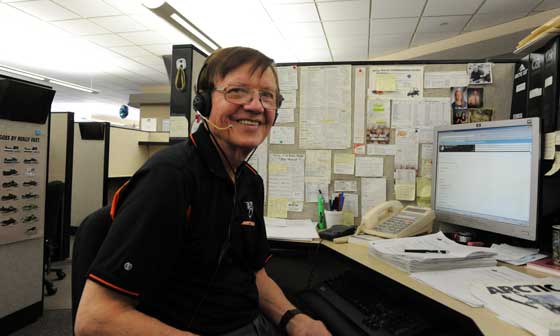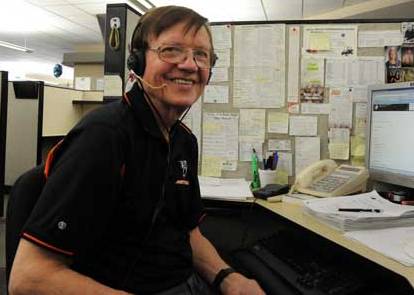
“Over the years, when we faced a tough situation with a really angry customer, I always connected that person with Dean. He always knew what to do… how to listen to the customer and help them in every possible way.”
-Pam Cwikla, Arctic Cat employee
With more than four decades at Arctic Cat, all in the category of Service and Technical Training, Dean Lawrenz has experienced a lifetime of service-related challenges and satisfaction. Though he was unwilling to share his age, the spry Lawrenz (he still walks more than four miles a day) was gracious enough to answer some questions about his job and his years at Arctic Cat.
AI: What’s your job title, and then explain what you do on a daily basis?
Lawrenz: I’ve held many different Service training jobs during my time at Arctic Cat. Since 2000 I’ve been the International Service Technician, which consists of helping our overseas service and parts technicians with any challenges they’re dealing with. I spend my days on the phone and computer, communicating with these techs. I love my job… so much that when I’m forced to use my vacation days, I still pop in just to see what’s going on here. This place has been my life for four decades.
Lawrenz has been integral to the creation of many Arctic Cat service manuals, specification manuals, reference guides and other related information.
AI: What are some of the other jobs you’ve held?
Lawrenz: Well, my history in the powersports industry began when I moved to Thief River Falls in 1969 to work for Long Engineering, who was modifying the Hirth, Kohler and JLO engines for the Arctic Cat Factory Mod sleds. When Arctic Cat switched to Kawasaki engines in 1971, the chrome-plated cylinders put an end to Long’s mod shop, and I got a job with Cat in the Customer and Dealer Service Department. There were two of us whose job was to take calls from dealers and customers who had service or parts-related question.
Dean is on the front row, far left of this photo from a 1978 Arctic Cat factory 4-day service seminar.
From 1973-1981 I did product service training seminars, as well as helping produce service manuals, reference guides, newsletters and training manuals.
I was the Service Manager from 1985 until getting my current role in 2000.
It’s been a lot of years, and I’ve loved every job I’ve had here.
Dean Lawrenz (L) and Kent Espeseth from a 1977 issue of the Spirit Outboards Newsletter.
AI: That is a lot of years! What’s your employee number?
Lawrenz: I’m employee #102. There aren’t too many people still working here with a lower number than mine.
A reprisal of the famous Arctic Cat “condo crew,” taken in 1999 by C.J. Ramstad for the second edition of the LEGEND book. L-to-R: Brian Espeseth, Ole Tweet, Roger Skime, Dennis Zulawski, Dean Lawrenz and Dave Thompson.
AI: What did you do during Arctic Cat’s “Gone Fish’n” years of 1981-83?
Lawrenz: I ran the Cuyuna Engine Service Department in Crosby, Minn. They were still building engines for ultra-light aircraft.
I also bought the Lantern restaurant in Thief River Falls, which I continued to own until I sold it six years ago.
When Arctic Cat came back in 1983, my job was working with Brian Espeseth to take care of parts, put together service manuals, create service schools and of course work to resolve service challenges with dealers and customers. That was a very exciting and gratifying time.
An Arctic Cat “Shop Talk” column penned by Lawrenz in 1978.
AI: What part of your job gives you the greatest satisfaction?
Lawrenz: Being able to help our technicians resolve whatever challenges they face.
AI: What is the greatest challenge of your job?
Lawrenz: Often my greatest challenge is to understand exactly what the real issue is when talking with our overseas techs.
AI: Like many people at Arctic Cat, you’ve also been involved with racing over the years. Tell me about that.
Lawrenz: Well, like I said before, my first job was modifying the Arctic Cat Factory mod engines. Once I started working in Service, my racing efforts included prepping the I-500 cross-country race sleds that the Factory oval racers would compete on, like Larry Coltom and Bob Elsner. We’d have those sleds built and ready for them to race, and often the first time they rode those sleds was when the green flag dropped for the first day.
More recently, I helped wrench for Brian Espeseth’s kids when they raced, about four years ago.
It’s interesting, but I’d always get service questions from people who wanted to know if the set-up info that we gave out was really what the factory guys were using. It always was. We never withheld any information from our independent racers.
AI: Do you own snowmobiles and/or ATVs?
Lawrenz: I have a 1994 ZR700 that’s modified with twin pipes and engine porting. I usually ride around 1,000 miles a year. A favorite ride of mine is from my home, which is located on the Red River about one mile out of Thief River Falls, to the town of Trail, where they serve the best hamburgers that I know of. I’ll ride there for dinner, and then ride home.
AI: What’s your all-time favorite Arctic Cat and why?
Lawrenz: I have two: The 2012 F800 because it handles great and is fast; and the other is my ’94 ZR, which also handles well.
AI: Tell me a good Roger Skime story.
Lawrenz: I have known Roger for many years and he is really a good guy to work with. He works at full throttle and is always positive.
Dean talks with friend and co-worker, Pam Cwikla
Thanks for reading!
